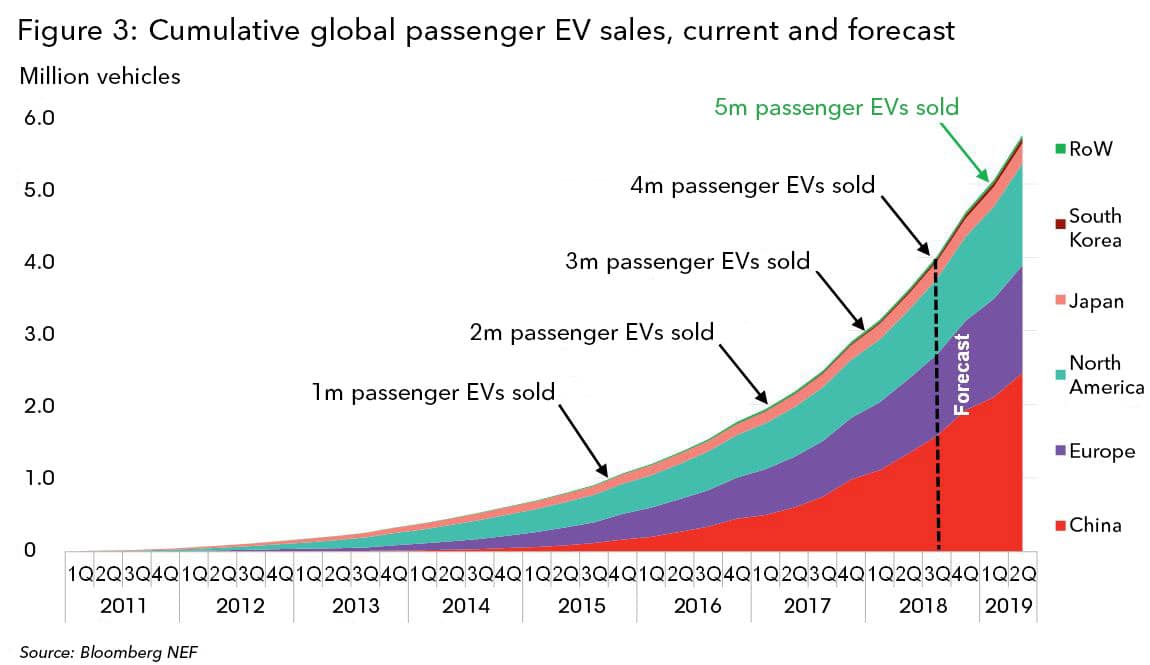According to a new report published by BloombergNEF, cumulative global EV sales will reach four million this week. If e-bus sales are counted, however, the milestone was already surpassed at the beginning of July.
Providing context to the achievement, BloombergNEF analysts calculated that while it took over 60 months to reach the first million EV sales, it took the fourth million just six months. Taking this line of growth, the analysts expect EV sales to reach five million by May 2019.
Not only has the pace at which EV cars are rolled out changed, but the global distribution has also shifted. For the first million sales, reached in the fourth quarter of 2015, North America was the most significant contributor, comprising 39%. This was followed by Europe, with 33%, while China registered just 15%.
However, China now comprises 37% of all passenger EV sales in the world since 2011, and around 99% of e-buses. This trend is likely to continue, with the analysts expecting 42% of the next million EVs until the five million milestone, to be sold in China, while Europe is projected to account for around 26%, and North America, 25%.

Recently, it was reported that Europe now has one million EVs on its roads. By May 2019, the analysts assume that number will increase to 1.3 million. Likewise, China’s recently introduced NEV quota will enter into force in 2019, thus serving to further accelerate sales.
Second life use cases
Soaring EV sales numbers have recently sparked increasing interest in second-life EV battery use cases. According to a seperate report, published by IDTechEx, batteries are the most expensive component of an electric car.
By their end-of-life, the batteries still retain 70-80% of their initial capacity. And there are a number of use cases resulting from this, mostly in stationary storage applications. An example of this is the 2.8 MWh storage system, recently installed at the Johan Cruijff ArenAin Amsterdam.
The system combines power conversion units provided by U.S.-based power management company, Eaton, and the equivalent of 148 new and second life Nissan LEAF batteries.
While the first batch of EVs are just reaching their end-of-life now, the analysts say that by 2029, around three million battery packs will be available for second life use, representing 108 GWh of available storage capacity.
In October last year, BloombergNEF said in another report that the global storage market will reach 305 GWh by 2030. As such, second-life EV batteries could account for one-third of storage installations.
This content is protected by copyright and may not be reused. If you want to cooperate with us and would like to reuse some of our content, please contact: editors@pv-magazine.com.









By submitting this form you agree to pv magazine using your data for the purposes of publishing your comment.
Your personal data will only be disclosed or otherwise transmitted to third parties for the purposes of spam filtering or if this is necessary for technical maintenance of the website. Any other transfer to third parties will not take place unless this is justified on the basis of applicable data protection regulations or if pv magazine is legally obliged to do so.
You may revoke this consent at any time with effect for the future, in which case your personal data will be deleted immediately. Otherwise, your data will be deleted if pv magazine has processed your request or the purpose of data storage is fulfilled.
Further information on data privacy can be found in our Data Protection Policy.